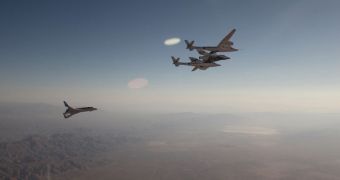British billionaire Sir Richard Branson's company Virgin Galactic is on the fast-track towards becoming the first privately-owned corporation to provide suborbital spaceflights on its own ships. Engineers at the company have been testing various spacecraft for many years, but the beginning of a new age in space transportation is now within reach. Officials at Virgin Galactic say that their SpaceShipTwo vessel could perform its first drop test as soon as this fall. A success then would bring the company closer to starting actual spaceflights than ever before.
The concept that Virgin Galactic is pursing is fairly simple. Engineers rely on a very large airplane (mothership) called the WhiteKnightTwo to carry a smaller aircraft, the SpaceShipTwo, to a high altitude. Once this target is reached, the craft carrying the passengers separates from its carrier and ignites its own boosters. This allows it to reach the edge of space, and to provide paying customers with the possibility to experience weightlessness for a few minutes. The SpaceShipTwo then reenters the atmosphere, and lands on its own on a regular airport.
“There's a reasonable possibility that we could see the first drop flight in the fall, but as always, everything is predicated on thoroughness and safety. No corners will be cut in order to achieve arbitrary deadlines,” Stephen Attenborough says. The Virgin Galactic commercial director told Space in an e-mail interview that the first drop test flights could take place over the Mojave Desert, in California, as soon as this fall. “Scaled [Composites] will need to evaluate the data from this recent captive carry flight before we know [when to conduct the next test]. It is true to say though that to date testing of both vehicles is progressing very smoothly,” the official adds.
Speaking about last week's test flight, which saw the Virgin Galactic aricraft conduct its first crewed operations, Attenborough says that: “The flight lasted over 6 hours and numerous combined vehicle systems tests were conducted. All the objectives of the flight were met.” The company plans to charge customers up to $200,000 for each suborbital flight. Launches will take place from the Mojave Air and Space Port in California. The facility is being constructed specifically to accommodate such experimental aircraft and space ships.

 14 DAY TRIAL //
14 DAY TRIAL //